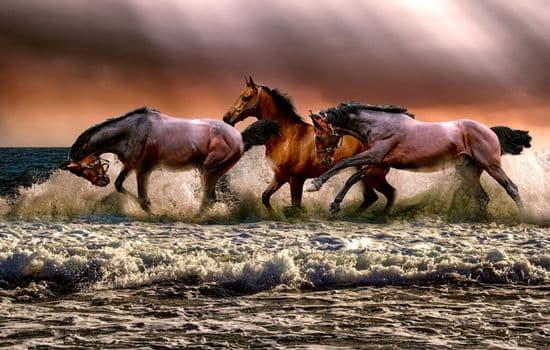Advertisements
These charming animals are quadrupedal mammals of the Equus genus. They are over 1.50 m tall and weigh over 500 kilos.
They also belong to the genus Equus, the donkey and the zebra. Brazil has dozens of horse breeds.
Advertisements
We have, for example, the following breeds: Creole, Pantanal, Manga Larga, Quarter Horse, Thoroughbred English and Thoroughbred Lusitano.
Main Features
They are mammals, therefore, their bodies are covered in fur.
Advertisements
See also
And the color of the animals' fur varies between light brown, dark brown, black, white and with spots.
Quadrupedal animals, therefore, use four limbs for locomotion.
The height of horses varies according to the breed. They are around 1.40 m to 1.70 m (height from the front legs to the end of the neck).
See Also:
The weight varies between 400 kilos and 1 ton.
A mare's gestation period lasts around 11 months. After they are born, they are breastfed until they are seven months old.
How horse feeding works
They are herbivorous animals, so they feed on plants. And they are not ruminants like oxen and cows.
They have a simple stomach, they are monogastric. Fibers are digested in the large intestine.
The importance of horses for human development
The horse was extremely important for the development of human beings.
They were widely used in the past, and still are today, for transporting cattle.
They currently stand out in horse riding, dressage, polo, jumping, vaquejada and rodeo.
It also helps in the production of serums, such as antivenom, which neutralizes snake venom.
What is the difference between a donkey, a mule and a donkey?
The mare is the female horse and they reproduce among themselves.
The crossing of a horse with a donkey produces sterile descendants, the donkey, the mule and the donkey.
See the meaning of each intersection:
- Donkey: born from the crossing of a donkey with a mare. The donkey is the male.
- Mule: born from the crossing of a donkey with a mare. The mule is the female.
- Bardoto: born from the cross between a horse and a donkey.
Wild horses
THE Przewalski's horse (Equus ferus przewalskii) is a wild horse that is found in Mongolia.
They are classified, in the List of Threatened Species of the International Union for Conservation of Nature (IUCN), as a breed in danger of extinction (endangered).
They were once classified as extinct. However, captive breeding programs were carried out with successful reintroductions and they returned.
Wild horses differ from domestic breeds, as their mane is shorter and more erect.
In addition to its tail having short hairs on the upper part, this has a dark stripe that goes from the mane to the tail.
In winter, they grow a thick mane, which they lose in spring.
These animals are smaller than domestic horses and their heads are larger.
Horses and their curiosities
- Horses spend long periods of time feeding. They spend between 12 and 18 hours grazing.
- They have a life expectancy of approximately 25 years.
- Horses that are kept locked up for a long time can develop emotional disorders. So if your horse is showing abnormal behavior, it means that he is being handled incorrectly.
- No one knows for sure when horses were domesticated. Some authors claim that the process may have occurred in Central Asia around 3000 BC.
- They arrived in Brazil in 1549 on the Caravel Galva and came from the island of Cape Verde.
- A mare pregnant with a donkey has a longer gestation period than a mare pregnant with a horse. The duration varies between 360 and 375 days.
- Horses communicate through body language. And this communication extends to other groups, such as humans.
- They demonstrate their emotional state, whether it's depression or when they feel threatened, through their body and facial expressions.
- Horses have three sleep phases:
1st phase: superficial sleep, he remains standing, with one of his limbs flexed, ears relaxed, neck and rump low.
2nd phase: medium sleep, the animal lies down with its chest on the ground, as well as the tip of its snout, keeping its neck raised.
3rd stage deep sleep: he lies down completely.

Horses help in the treatment of diseases
Equine therapy is a medical treatment combining physiotherapy exercises with horseback riding.
This therapy is recommended for people with motor coordination problems. It helps improve balance and posture and develops body movements.
They help develop balance and proper posture for people who suffered cerebral palsy during childbirth.
It is also recommended for people who suffer from hyperactivity, psychomotor delay and genetic syndromes.
Many hospitals are betting on including animals as a way to bring joy into patients’ lives.
And many people use horses as stimuli for the sick, as the animal's love can help in the recovery of health.
The importance of equine therapy is so great that its day is celebrated on August 9th.
